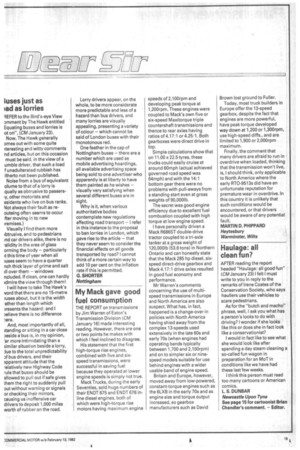My Mack gave good fuel consumption
Page 17

If you've noticed an error in this article please click here to report it so we can fix it.
THE REPORT on transmissions by Jim Warren of Eaton's Transmission Division (CM January 16) made interesting reading. However, there are one or two points he makes with which I feel inclined to disagree.
His statement that the first high-torque rise engines, combined with five and sixspeed transmissions, were successful in saving fuel because they operated at lower engine speeds is simply not true.
Mack Trucks, during the early Seventies, sold huge numbers of their ENDT 675 and ENDT 676 inline diesel engines, both of which were high-torque rise motors having maximum engine speeds of 2,100rpm and developing peak torque at 1,200rpm. These engines were coupled to Mack's own five or six-speed Maxitorque triple countershaft transmissions and thence to rear axles having ratios of 4.17:1 or 4.25:1. Both gearboxes were direct drive in top.
Simple calculations show that on 11.00 x 22.5 tyres, these trucks could easily cruise at around 60mph (actual achieved governed road speed was 64mph) and with the 14:1 bottom gear there were no problems with pull-aways from a standing start even at gross weights of 90,000lb.
The secret was good engine efficiency due to excellent fuel combustion coupled with high torque at low engine speed.
I have personally driven a Mack R686ST double-drive tractor coupled to a tri-axle tanker at a gross weight of 120,000lb (53.6 tons) in Northern Ontario and can honestly state that the Mack 285 hp diesel, sixspeed direct-drive gearbox and Mack 4.17:1 drive axles resulted in good fuel economy and performance.
Mr Warren's comments concerning the use of multispeed transmissions in Europe and North America are also suspect. What has, in fact, happened is a change-over in policies with North America having shied away from the complex 13-speeds used extensively in the late 60s and early 70s (when engines had operating bands typically between 1,700 and 2,100rpm) and on to simpler six or ninespeed models suitable for use behind engines with a wider usable band of engine speed.
Britain and Europe, however, moved away from low-powered, constant-torque engines such as the 6LXB in the early 70s and as engine size and torque output increased, so gearbox manufacturers such as David Brown lost ground to Fuller.
Today, most truck builders in Europe offer the 13-speed gearbox, despite the fact that engines are more powerful, have peak torque developed way down at 1,200 or 1,300rpm, use high-speed diffs., and are limited to 1,900 or 2,000rpm maximum.
Finally, the comment that many drivers are afraid to run in overdrive when loaded, thinking that the transmission won't live, is, I should think, only applicable to North America where the early RTO-9513s did have an unfortunate reputation for premature wear in overdrive. In this country it is unlikely that such conditions would be encountered, or that drivers would be aware of any potential fault.
MARTIN D. PHIPPARD Heytesbury Warminster, Wilts
















































